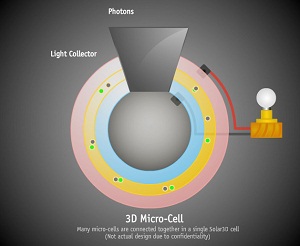New company to manage solar in 3D
 Solar3D, a California start-up, submitted a patent application last week for a technology that CEO Jim Nelson believes will revolutionize the solar industry.
Solar3D, a California start-up, submitted a patent application last week for a technology that CEO Jim Nelson believes will revolutionize the solar industry.
“Traditional solar panels let the sun give what it will give without managing the light,” Nelson said.
Typical photovoltaic solar panels reflect about 30 percent of the light that hits them, Nelson said. He aims to change not only that, but also how the cells manage the light they attract and trap. Normal solar cells absorb a large percentage of the electrons they knock loose, never converting them to energy, Nelson said.
Solar3D wants to change all of that by changing the shape of a solar cell. Rather than the typical flat two-dimensional surface, Nelson said Solar3D would create a three-dimensional cell using thinner materials in the absorbent areas in order to avoid wasting trapped electrons before they can be converted into energy.
“We see it as we are predators of light,” Nelson said. “Any light that touches our surface, we will grab it.”
He said the idea was born when he began working with some fiber optics engineers. When these great minds in another industry put their heads to solar, Nelson said there were fireworks. They realized they could apply some of the same principles of light management they use in fiber optics development to solar, he said.
“The solar cell is pretty much the same thing it’s been for the last 100 years,” Nelson said. “No one has taken the time to reengineer it.”
He compared solar cells to cars. He said that the automobile today is still the same basic thing it was when it was first created 100 years ago, but its been reengineered to be more efficient, faster, cleaner and easier to drive.
“When you look at all technology over the last hundred years,” he said, “or maybe even longer than that, probably forever, this is how it starts. It starts and stays the same until someone decides to reengineer it.”
He said he expects Solar3D to max out the theoretical efficiency limits of any material the company applies to its new technology. It will start with silicon, the readily available material traditionally used to manufacture solar cells.
Nelson said he expects Solar3D to produce a prototype of its product by the end of 2011 and then begin shopping around for a partner to manufacture it.
Image courtesy of Solar3d.



